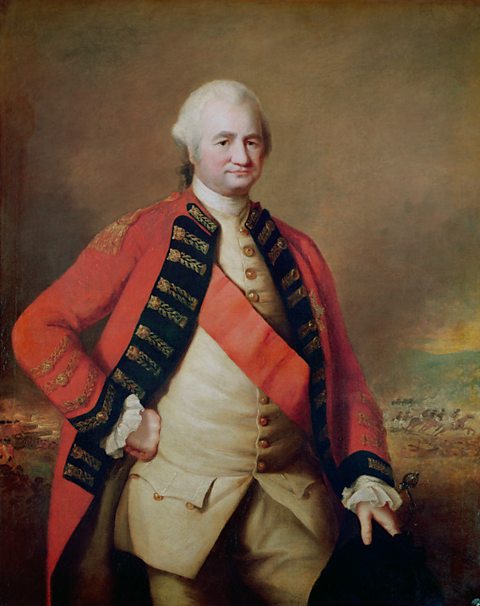Key points
- From 1757, Britain increased its control of India through the East India CompanyA company that was founded in England in 1600 with the aim of trading in Asia. From 1757 - 1858 it controlled much of India..
- From 1858 onwards, the British government directly ruled India, and it became known as the British Raj.
- The British Raj had a significant impact on people living in India. Many Indians suffered from extreme poverty and famines during British rule.
- The British government and British individuals gained a lot of wealth from trade with India, which they used in part to fund the Industrial Revolution.
British Empire overview activity
Learn more about some of the key events in the history of the British Empire with this activity.
The East India Company

In 1600, Queen Elizabeth I approved the creation of the East India Company, a powerful private trading company. The East India Company was started by merchantA person involved in buying and selling items, usually between different countries. In the British Empire, this was done using a lot of force and violence when local people did not cooperate with the merchants. who wanted to trade in Asia to get spices, cotton and indigo dye and then sell them in England for profitThe money that is made from buying and selling goods after costs have been taken into account..
At first, they sailed to the East Indies, which are now modern-day Indonesia and the Philippines, and tried to compete with the Dutch, French and Portuguese merchants who were already there. They failed to compete and The East India Company turned their attention to southern India.
In 1639, a company representative purchased land in southern India. The East India Company built Fort St George on this land, which has since become part of the city of ChennaiA city in the southern Indian state of Tamil Nadu. Until 1996 it was known as Madras., now home to over 11 million people.


How did the East India Company take control of India?
Initially English traders were welcomed by the Mughal rulers. Both sides realised that there would be benefits for each of them if they traded with each other. In exchange for trading rights the English brought European products to India. Throughout the 1600s English trade in India expanded and English traders built many trading postA base from which people traded goods. and factories across India. However, by the end of the century relations with the Mughal rulers had worsened.

When further English requests for trading privileges were turned down, the East India Company ports and fought battles against the Mughal army. This conflict became known as the Anglo-Mughal War, and it lasted from 1686 to 1690.
The English lost when the Mughal EmperorThe ruler of the Mughal Empire, which lasted from the early 1500s until 1858. It ruled over much of modern-day India, Pakistan, Bangladesh and Afghanistan., Aurangzeb, defeated the English merchants. He did not think the merchants were a serious threat and was satisfied with the English apologising and paying a fine.
Aurangzeb was much more worried about fighting off the Maratha EmpireAn empire that controlled much of modern-day India and Pakistan in the second half of the 1700s. and so did not impose any harsher punishments on the English.

What impact did the death of Aurangzeb have on the East India Company?
There was a big change after the death of Aurangzeb in 1707 as local princes fought to take the place of the emperor. The East India Company began to take advantage of the chaos and offer their support to the local princes in return for money and goods, which they used to build a private army that could challenge the local princes.
The Battle of Plassey

By the 1750s the British and French trading companies were the largest in India, and both wanted to control trade. In 1756 Siraj ud-Daulah became the NawabA Muslim ruler of Bengal, who was typically loyal to the Mughal Emperor. of BengalAn area of South Asia that is today made up of Bangladesh and the Indian state of West Bengal.. He grew frustrated with the British presence in Bengal and the British East India Company grew frustrated because they thought he preferred working with the French.
In 1757, ud-Daulah captured Fort William, a British fort in Kolkata, after the British refused to stop extending the fort. The British, led by Robert Clive, planned to take back the fort, and the two sides met at Plassey. Ud-Daulahās army outnumbered the British army, and some French soldiers joined ud-Daulah. However, the head of the Bengali army, Mir Jafar, had secretly made a deal with the British, agreeing to switch sides in exchange for being made the new Nawab of Bengal after ud-Daulah was overthrown. Jafar promised to work in support of British interests, and the British planned to use him as a puppet rulerA person who seems to be in charge, but is actually controlled by another person, group of people or country..

Why was the position of Nawab of Bengal so significant?
The Nawab was the leader of Bengal, which in the early 1700s was a part of the Mughal Empire. While the Nawab of Bengal was typically loyal to the Mughal emperor, he was effectively able to rule Bengal independently.
Bengal was an important part of Mughal India because it was very wealthy. Its coastal location meant it had a large shipbuilding industry. Bengalās significant textile production made it a centre of international trade.
The consequences of the Battle of Plassey
Ud-Daulah lost the Battle of Plassey and Mir Jafar was installed as the Nawab of Bengal. This victory is considered by many historians to be the beginning of British control of India. However, Britain did not direct ruleWhen one country is completely controlled by another country's government. India at this point, because the East India Company was still the controlling power rather than the British government.
1757 was a turning point for the East India Company for three main reasons:
- The Battle of Plassey was fought and Siraj ud-Daulah, who preferred the French to the British, was defeated.
- Competition from the French East India Company was removed.
- The East India Company established a puppet ruler in Bengal, Mir Jafar, to allow them to control India.
How did the East India Company change the lives of Indians?
In the 1700s much of India was divided into individual principalities and different empires. Following the British victory at the Battle of Plassey, some Indian princes were removed from their positions of power by the East India Companyās private army. This army was largely made up of Indian soldiers called sepoyAn Indian soldier who fought in the East India Companyās army, but had previously been part of the Mughal army. .
However, other Indian princes kept their positions if they promised to support the East India Company and favour British interests.
Some ordinary Indians turned British control to their financial advantage, such as shipbuilder Jamsetjee Bomanjee Wadia. He became wealthy by building ships for the British East India Company.
However, for many Indians, life under the control of the East India Company meant poverty and violence from British merchants. Indian workers were forced to sell their goods to the British at very low prices and were then made to buy British products at much higher prices.
High levels of poverty and high taxes left Indians particularly vulnerable when famines hit the region, as they struggled to afford food.
What was the Bengal famine of 1770?
Between 1769 and 1770 a famine hit the Bengal region. Due to bad weather the harvest had failed to produce enough crops. Many farmers had no reserves of food because they had had to sell their food to afford the high taxes demanded by the East India Company.
The East India Company did not put a relief plan in place, and up to 10 million people died of starvation and illness. This was the first of several famines to hit India during British rule throughout the 1700s and 1800s.
The 1857 Rebellion
From 1757, the East India Company began to control the government, economy and education system of India.
By 1857, the sepoys in the East India Companyās army began a rebellion after a rumour spread about a new rifle they would be receiving. To load the rifle soldiers believed they would have to bite off the end of a cartridge which was covered in pigsā and cowsā grease. This would have been an insult to both Muslims and Hindus, as it is against the religious beliefs of Muslims to eat pig products and it is against the religious beliefs of Hindus to eat cow products. These events increased the feeling that the British were not respecting Indian values.

In March 1857 a sepoy named Mangal Pandey attacked his British officer and was executed. By May, the rebellion spread as tens of thousands of other sepoys turned on their officers, in some cases killing them. Although the sepoys initially had some successes and took some territory, the British defeated the rebellion after 18 months of fighting. In August 1858, the Government of India Act was passed and direct British rule of India began.
It is estimated that several thousand British were killed during the rebellion, while the estimates for the Indian death toll are in the hundreds of thousands. Many British and Indian civilians were also killed in the violence, and many lives were also lost to a famine that occurred at the same time as the rebellion.
Why was the 1857 Rebellion a turning point for British rule in India?
A significant consequence of this rebellion was that it began the direct rule of the British government over India after a British victory against the sepoys. The East India Company was no longer in control, the British government was. The huge amount of money made from colonising India, as well as the fact that some of the current crown jewels were taken from India, is one of the reasons some historians say the colony became known as the ājewel in the crownā.
How did the British Raj change the lives of people in Britain?
The East India Companyās control of India significantly impacted the British economy. Britain was able to export vast quantities of goods such as tea and pepper and sell them for a great profit. This profit helped to fund the Industrial Revolution in Britain. For example, it was used to build textile factoriesFactories that turn raw materials into sheets of fabric and clothes., which employed many people.
Imports such as silk and cotton were brought from India and turned into expensive clothes and fabrics before being sold at a higher price back in India. The profits made by the East India Company were invested in Britain. Factory owners in particular earned a lot of money from trade with India.
Although factories in Britain provided work, the conditions were often dangerous due to a lack of concern over health and safety. Textile factories particularly employed women and children, who had to work long hours and faced harsh punishments if they worked too slowly.

Test your knowledge
Play the History Detectives game! gamePlay the History Detectives game!
Analyse and evaluate evidence to uncover some of historyās burning questions in this game.

More on The British Empire
Find out more by working through a topic
- count3 of 4

- count4 of 4

- count1 of 4
